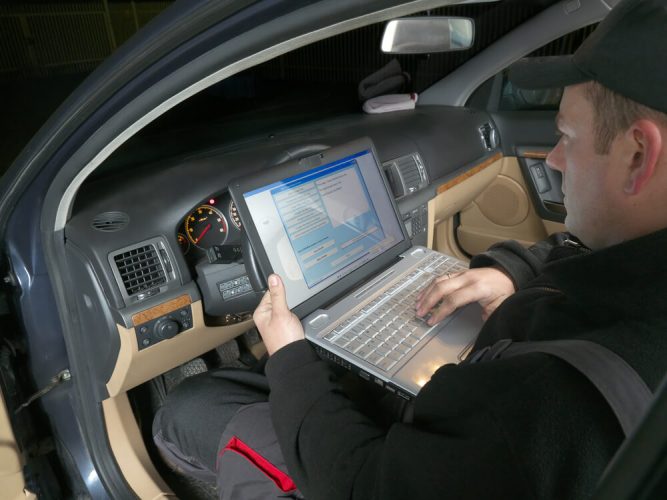
When going to the mechanic, updating your insurance, or registering your car, you may be asked about your car’s VIN. But what is a VIN number, and where is the VIN number on a car? This guide explores everything you need to know about this important ID to ensure you have all the information you need when it comes to your vehicle and getting auto insurance.
What is a Car VIN Number?
A VIN, or vehicle identification number, is a 17-character code assigned to your specific vehicle. It is a unique identifier for your vehicle, much like a license or social security number for a person. Information about your car, like its ownership history and past accidents, is directly connected to this number.
Why Knowing Your Car’s Identification Number is Crucial
Knowing your car’s VIN is essential for keeping track of important details about your vehicle. If you’re wondering, “Why do I need a VIN number?” there are plenty of situations where this ID will come in handy.
You may be asked to input your car’s VIN when applying for a new insurance policy or renewing your registration. If your car is ever stolen, despite your best efforts to avoid car theft, having the VIN can help you track your vehicle down and prove that you own it. As a result, it’s important to know where to find your VIN on your car and have it recorded in a safe place outside of the vehicle.
Effortless Strategies to Uncover Your VIN
In most cases, your VIN is displayed somewhere on your vehicle. Knowing where to find it is key to keeping track of your vehicle’s history. Here are some basic tips for finding the VIN.
Common Places to Find Your VIN on the Car
Depending on the make, model, and age of your car, the VIN may be located in a few different places. It can be on a plate, a sticker, or stamped directly on your vehicle. A few common spots to check include under the windshield on the driver’s side of the dashboard, or in the driver’s side door. You can also check on the engine’s firewall, on the engine block, or on the car radiator. If you can’t find it in any of those places, check in the wheel well or under the spare tire.
Documents That Can Help You Locate Your VIN
You can check your car’s manual to find where the VIN is located on your specific make and model. If you don’t want to search your car, however, you can also find it on your car’s title, registration, insurance policy, or records from the mechanic.
Understanding Different Types of VINs
There are actually two types of VINs: the 17-character version that you use to identify your car and a shortened version used by law enforcement. Here’s a breakdown of each:
Decoding the 17 Characters of a VIN
Each section of the 17-digit serial number aligns with a different aspect of the car and its production. These include:
- The country where the car was manufactured
- The manufacturer
- The make
- The body style
- The engine size
- The model year
- Security information
- The assembly plant
- The car’s serial number
Confidential (CON) VINs and Their Purpose
Confidential VINs (CON VINs) are shortened versions of the full ID that also align with your specific car. On newer cars, they’re installed in harder-to-find areas of the body and engine and are designed specifically for use by law enforcement. Like glass-etched codes, these IDs discourage car theft and prevent illegal vehicle cloning.

Overcoming Challenges in VIN Location
While VIN location is standard in most modern cars, these numbers can be harder to find on certain vehicles. If you can’t find yours, see if any of these situations apply.
Antique Cars and Non-Standard VINs
VINs were first introduced in the 1950s, and they didn’t become standardized until 1981. If you have an older car, you may have a non-standard VIN. As long as your car was produced before 1981, your non-standard VIN will still be valid.
Handling Missing or Illegible VINs
If you have an antique car without an identification number or a car with an illegible VIN, contact your local DMV to learn about the policies in your state. You’ll likely have to go through an inspection process to confirm the missing ID and set you up with a legitimate title.
Frequently Asked Questions About VINs
Here are a few FAQs to help you learn more about your car’s identification number.
Can I Decode My VIN to Find Out Specific Features about My Car?
You can use a VIN decoder tool to see what each character means about your vehicle. Enter the full ID in a decoder, along with some basic information about your car, to get a report.
How Can I Get the VIN Number for a Car I No Longer Have?
Looking up the VIN for a previous vehicle involves searching through your own records, such as insurance documents and service reports. You may also be able to contact the DMV or your insurer.
How Can I Get the VIN Number for My Car That’s Been Stolen?
If you don’t have it written down, you may need to know how to find a VIN number for a stolen car. You can use online lookup services, reach out to your insurance company, or contact law enforcement to secure the identification number.
Do VIN Numbers Get Reused?
Your car’s vehicle identification number is unique, so it will never get reused or repeated. This is what makes these IDs so useful for keeping track of your car and its history.
Can I Look Up My VIN Number Online?
Some vehicle history reporting services allow you to find your VIN online with other information, like your car’s registration info. This can be especially helpful if you want to learn more about buying a used car, or if you’re considering buying a car from a private seller.
Is My VIN Number On My Car Title?
Your VIN is included on your car title as part of your proof of ownership. But where is the VIN number located on a car title? It’s usually prominently displayed near the top of the document, but it can vary by state.
Is There a Difference Between a VIN and a Chassis Number?
Many people use the term chassis number interchangeably with VIN, which is accurate for modern cars. However, chassis numbers were used before the official VIN system was adopted. As a result, some older chassis numbers may be different than VINs.
Getting Started with Affordable Auto Insurance
Once you’ve located your VIN, find a Freeway Insurance location near you to secure coverage for your vehicle. Call us at 800-777-5620 or contact the Freeway Insurance team to get a quote online for your insurance policy today.



